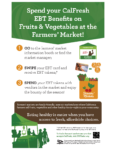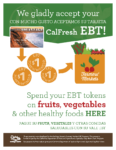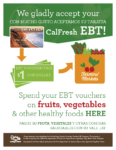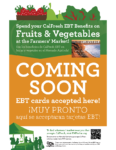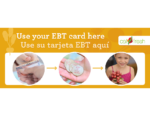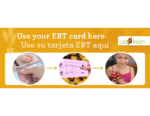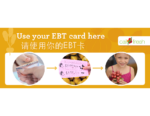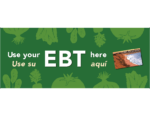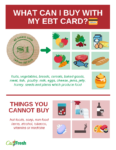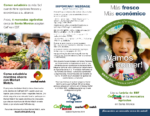Farmers' Market EBT Program
 The Ecology Center’s Farmers’ Market EBT Program assists farmers’ market operators and community partners in establishing, implementing, and promoting CalFresh EBT access at farmers’ markets and other direct-marketing locations. This project has been funded at least in part with federal funds from the U.S. Department of Agriculture and people like you.
The Ecology Center’s Farmers’ Market EBT Program assists farmers’ market operators and community partners in establishing, implementing, and promoting CalFresh EBT access at farmers’ markets and other direct-marketing locations. This project has been funded at least in part with federal funds from the U.S. Department of Agriculture and people like you.This online toolkit is designed to assist farmers’ market managers, associations, Board members, and farmers in establishing or bolstering their farm-direct outlet’s CalFresh EBT program. If you are a customer interested in learning more about CalFresh visit the California Department of Social Services site or check out our Farmers’ Market Finder to find a farmers’ market near you that accepts your CalFresh EBT card.
Learn more about why you should add EBT to your farmers’ market or farm and how we can help!
Contact Us
Email: ebt@ecologycenter.org
Phone: 510-925-4001
Follow the Market Match Facebook page
Find your market on Farmers’ Market Finder and reach out if your listing needs updatingHISTORY
When food stamps moved to an Electronic Benefits Transfer system in 2003, farmers’ markets and the farmers they served were left out of the loop.The Ecology Center worked with state and federal agencies to select and pilot the Single Point of Sale and Scrip model that is now used across the state. Since pioneering California’s Point of Sale model (POS) at the Ecology Center’s Berkeley Market in 2003, the Farmers’ Market EBT Program has worked with hundreds of markets statewide to identify the barriers to CalFresh EBT adoption and overcome them. To date, we’ve assisted over 350 individual markets statewide with their EBT Programs.
What is a Certified Farmers' Market?
A Certified Farmers’ Market (CFM) is a “point of sale” location for California agricultural products. CFMs are usually set up on a weekly basis for California farmers and ranchers (“producers”) to gather together and sell their agricultural products directly to the public.A Certified Farmers’ Market may only be operated by a local government, a certified producer or a non-profit organization. CFMs must be authorized by the county agricultural commissioner and abide by current legislation and regulations. In addition, CFMs should follow established market rules. Market rules are the set of written rules each CFM develops as its blueprint for activities and operations.
Only producers certified by the county agriculture commissioner may sell at a CFM and must display their Certified Producer Certificate, and a sign with language akin to “We Grow What We Sell.” The re-sale of agricultural products at a CFM is prohibited.
While the look and feel of Certified Farmers’ Markets throughout the state varies greatly from county to county, the one thing they all have in common is the selling of agricultural products grown or raised in California. They ensure a direct connection between consumers and the farmers that grow their food. Being a CFM also opens up the opportunity to take advantage of the free POS device program through the California Department of Social Services, as well as free resources from the Ecology Center when setting up an EBT program. It also allows you to be listed on the Ecology Center’s online farmers’ market search tool and map, Farmers’ Market Finder.
If you are interested in becoming a Certified Farmers’ Market and your market is located in one of the counties listed here, you can complete the online application. If your county does not participate in CDFA’s online application system, then you can contact your county agricultural commissioner’s office to find out how to register.
California Department of Agriculture Certified Farmers’ Market Program
(916) 900-5030
cfm@cdfa.ca.gov
https://www.cdfa.ca.gov/egov/farmersmarketFor more information or support with setting up a new Certified Farmers’ Market, please visit farmersmarketalliance.org
WHAT IS EBT?
Recipients of the Supplemental Nutrition Assistance Program (SNAP), known as CalFresh in California, are no longer issued paper food stamps. Instead, they are issued an Electronic Benefit Transfer (EBT) card where recipients can access their food benefits electronically by swiping their card at the point of sale.In order to accept CalFresh EBT cards, farmers’ markets typically establish a central Point of Sale (POS) model, allowing the market to sell EBT scrip to customers at a central point in the market. The customer then spends their EBT scrip with any eligible food producer in the market and the market manager later redeems the scrip for cash or in place of a stall fee. This system requires the farmers’ market manager or operator to become authorized as a SNAP retailer by Federal Nutrition Services (FNS) USDA, and to implement and promote the EBT program.
How does it work at the Farmers' Market?
The central Point of Sale (POS) and scrip system allows all eligible food vendors in a multi-vendor farmers’ market to sell eligible food products to CalFresh EBT recipients without each vendor needing individual authorization by the U.S. Department of Agriculture (USDA) Food & Nutrition Service (FNS). Click here to see a short video on this model.The central POS device is usually located at a staffed market information table or carried by an easily identifiable market staff person. Regardless of the location, market signage should direct EBT cardholders to the POS device.
The staff person asks the customer how much of her food benefits she would like to transfer to scrip. Then the staff person swipes the customer’s card, which debits the amount she requests from the balance stored on the card. (This amount is then transferred from the customer’s account to the market’s or association’s bank account.)
The staff person then issues scrip in the amount requested by the customer. The scrip can be either tokens or paper. (See the tab on the left, EBT SCRIP, for details and regulations.) The customer can use the scrip with vendors in the market to purchase eligible food products. At the end of the market day, vendors trade the scrip for cash, check, or a receipt for future payment from the market operator. The customer can return unused scrip for credit on her EBT card, or hold the scrip for later use. The operating market or association should maintain records and security systems for EBT scrip distribution and redemption. (See Staffing & Redemption Models)
How will this benefit my Farmers' Market or Farm?
CalFresh serves over 4 million clients with nearly $8 billion in federal nutrition benefits. When you add EBT access to your market, you open this $8 billion market to your farmers. Check out this two page argument on why your farmers’ market should add EBT access:
Free EBT Webinars
Free Training Webinars!
Click on the links below to view recordings of the full webinars.Adding EBT Access to Your Farmers’ Market
(Hosted February 2018)
Get an overview of all the steps and requirements to getting your farmers’ market EBT authorized. We cover filling out the FNS application, obtaining a free POS device, designing scrip, implementation at the market, as well as outreach and incentive programs. This webinar is great for farmers’ markets who are just starting the EBT authorization process.How to Run a Successful Farmers’ Market EBT Program
(Hosted June 2019)
Learn about common barriers for EBT shoppers, outreach to customers, creating community partnerships, how to access the Ecology Center’s free resources, and incentive programs. This webinar is great for markets who are interested in adding EBT, already have EBT access, and for markets interested in incentive programs. We encourage community agencies and organizations who are interested in partnering with farmers’ markets in their area to take advantage of this free information as well!Adding EBT to Your Farm-Direct Site (Farm stand, CSA, Mobile Market)
See also the slides and notes
(Hosted December 2020)
Get an overview of the process of adding EBT access to farm stands, CSAs, and mobile farmers’ markets. Whether you are a farmer, non-profit, or other type of organization, get your questions answered about the Food and Nutrition Service application, Point of Sale devices, marketing to EBT customers, and more. The International Rescue Committee’s New Roots Farm Stand manager shares his experience of adding EBT to their CSA/farm stand and improving accessibility for low-income customers.Expanding EBT at Your Farm-Direct Site (Farmers’ Market, Farm stand, CSA, Mobile Market)
See also the slides and notes
(Hosted February 2021)
The CalFresh EBT Program provides 4.8 million Californians an average of $166 for food each month. In this workshop, learn how to grow your EBT customer base by identifying and addressing barriers to EBT customers shopping at your market/farm. Let’s talk about how we can support a local food system that catalyzes inclusivity and belonging.
FARMERS’ MARKET EBT NEWS
Summer 2022 Newsletter: 2022 Market Match Impact Report and EBT access implementation assistance to 7 farmers’ markets in Northern California
Spring 2022 Newsletter: Market Match Annual Face to Face Meeting Recap and Anti-Racist Farmers’ Market Toolkit release by Farmers’ Market CoalitionWinter 2021 Newsletter: 2020 Market Match Program Accomplishments, Nutrition Policy Institute’s Evaluation of Market Match
Fall 2021 Newsletter: Increased State Funding for Market Match Meets Increased Need for Healthy Food Dollars
Spring 2021 Newsletter: Market Match Team Leads #FundCNIP Campaign, Market Match expands to 9 new partners and sites
Feb 2021 Newsletter Request for Proposals to join Market Match Opens
Winter 2020 Newsletter: Free webinar on Adding EBT access to our farm direct outlet and EBT technical assistance support available for farm direct outlets
Summer 2020 Newsletter: Racial & Food Justice, New Market Match Partners, Pandemic Response Food Resources
Spring 2020 Newsletter: RFA for Market Match Partners, CNIP/GusNIP Grant Awarded, National Training & Technical Assistance, New Team Members
Fall 2019 Newsletter: Small Farm Conference, New Alliance Video, New Team Member
Summer 2019 Newsletter: EBT Webinar, CalFresh Awareness Contest Winners, CalFresh Forum
March 2019 Newsletter: Face-to-Face Conference Highlights, FMSSG Wrap Up, New Kaiser Permanente Grant
December 2018 Newsletter: FM Finder 3.0 Launch, 2018 Farm Bill, New Team Members
July 2018 Newsletter: Novo Dia Group Ceasing Operations, Add CalFresh EBT
April 2018 Newsletter: CalFresh Awareness Month Instagram Contests, FNS Reauthorization, and EBT Training Webinar
February 2018 Newsletter: EBT Training Webinar, Apply to be a Market Match Partner, POS Device Fraud Warnings
December 2017 Newsletter: EBT Training Webinar, Upcoming RFA, Regional WIC Trainings
October 2017 Newsletter: Regional Flyers Available, Welcome New Team Member
December 2016 Newsletter: Free EBT Equipment Program, RFA
Winter 2013 Newsletter: Top 10 Benefits of adding an EBT Program
Fall 2013 Newsletter: Healthy Food Access Index
Summer 2013 Newsletter: Los Angeles Farmers’ Market Finder
September 2013, East Bay Express: Market Match
This project has been funded at least in part with Federal funds from the U.S. Department of Agriculture. The contents of this publication do not necessarily reflect the view or policies of the U.S. Department of Agriculture, nor does mention of trade names, commercial products, or organizations imply endorsement by the U.S. Government. USDA is an equal opportunity provider.
FNS Application
 THE BASICS
THE BASICS
In order to accept CalFresh EBT, you must complete the Food and Nutrition Service (FNS) Application. We recommend you use the online application. To sign into the application portal, first create an online account with a username and password. Once you start the application, you can save and return to it within 30 days. After 30 days, your account will remain active, but your unfinished application will be automatically deleted.Once you submit the online application, you must sign the signature page and send it along with supporting documentation, which varies depending on the markets’ ownership type.
If you are applying for multiple farmers’ markets at the same time, you will need to fill out a separate application for each location. If you are applying for more than 10 farmers’ markets at once, you may qualify as a Multi Store Owner (MSO). Contact FNS to see if you are eligible and for a separate form to use to apply for a large number of outlets at once.
Once the application is approved, USDA will issue your market or association a FNS number. Your farmers’ market is then considered an Authorized Retailer and may accept SNAP. From the time FNS receives the completed application, including the signature page and documentation, the authorization typically takes 30-45 days.
Note: A farmers’ market does not need to be a Certified Farmers’ Market and a farmer does not need to be a Certified Producer to become an authorized SNAP retailer.
THE DETAILS
There are some important differences in the application for a farmers’ market vs. another type of farm-direct outlet (farmer, farm stand, CSA, mobile market). Please see the guides below which give a detailed walk-through of the FNS application for each type of outlet:SITE VISITS
As part of the application process, a FNS representative may conduct a site visit to your market. The day of the visit, the representative will look for the market manager when they arrive at the market, and they will identify themselves to the manager. The manager will then sign a letter of consent for the site visit and have an opportunity to contact the SNAP Retailer Service Center if there are any questions about the visit. The site visits should take less than an hour to complete. The contractor will take photos of the market, conduct a product inventory, make a sketch of the market, and verify the market location.
FNS conducts site visits with all SNAP retailers, and they may either be before or after authorization. This will not delay the application process or have any impact on approval or disapproval of the FNS application.
FNS REAUTHORIZATION
Once your market becomes SNAP Authorized, you will need to renew your authorization every five years. When it is time for reauthorization, FNS will send you a letter in the mail with instructions. You will need to complete the reauthorization application within 30 days of receiving notice of reauthorization, so we recommend you fill it out and submit it as soon as you possibly can. Keep in mind, it may ask you to submit back up documentation, such as an ID or SSN, just as the original application did. For more information about the required supporting documentation, see our FNS Application Guides above.
CONTACTS
For questions about how to fill out the FNS Application:
Ecology Center Farmers’ Market EBT Technical Assistance Program
510-925-4001
ebt@ecologycenter.orgFor questions about the status of your application:
USDA Food Nutrition Service (FNS) Farmers’ Market Customer Service Hotline (for farmers’ markets only)
312-353-6609; Email Tarissa Johnson at Tarissa.johnson@usda.gov (farmers’ market contact at Food Nutrition Service)Or
SNAP Retailer Service Center (for all other farm-direct outlets)
877-823-4369Point Of Sale (POS) Device
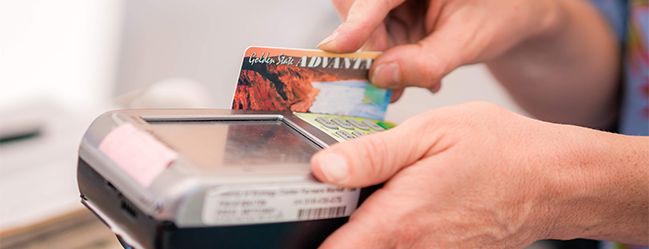
The next step is to determine what type of EBT Point of Sale (POS) device you will use to process EBT transactions. For eligible outlets, we recommend using the device provided by the California Department of Social Services (CDSS) because it is free and the state of California will pay all of the associated fees! See the sections below to determine your eligibility for the free POS device and view alternative options.We’ve received reports that private EBT vendors are aggressively reaching out to farmers’ markets to try to gain their business. Read more about it here.
Free EBT Point of Sale Device Provided by CDSS
Eligible outlets for the Free EBT point of sale device paid for by CDSS:
Certified Farmers’ Markets
Direct marketing farmers (you do not have to be a Certified Producer)
CSAs and farm stands run by 501(c)3 Nonprofits
Non-eligible outlets:
Non-certified Farmers’ Markets
Mobile Farmers’ MarketsAs soon as you submit your FNS application and receive your temporary FNS number, contact Jamecia Davis at Jamecia.Davis@dss.ca.gov at CDSS, so she can get your market/outlet into their system. You need not wait until you receive the SNAP permit/authorization is completely finalized before you start up contact with Jamecia.
Jamecia Davis
California Department of Social Services
(916) 420-5822
Jamecia.Davis@dss.ca.govJamecia Davis (CDSS) will send you a short questionnaire to determine your eligibility for a wireless device. Be sure to inform the Ecology Center and Jamecia of all market locations, days, and times where you intend to accept EBT, as both agencies maintain a list of all EBT accessible California farmers‘ market locations as well as those that offer incentives.
Once your FNS application is approved (authorization can take up to 45 days), FNS will send an email both to you and to CDSS. Jamecia (CDSS) will connect you to a representative from FIS Global who you will have to sign a contract with for a wireless EBT point of sale device (POS) to be ordered for your market/outlet.
Note: The State of California covers all fees related to the POS. You do not incur any costs when using a CDSS-issued POS. The CDSS-provided POS device can NOT accept credit and debit cards.
Alternate Technology
The POS device provided by the state will process EBT transactions only, without fees. It does not have the option to accept debit or credit cards. If you are not eligible for the CDSS device, or you would like a system to process all types of cards, you will want to research alternative options.There are a number of other point of sale options, some of which can be used with an iPhone or iPad. These alternatives may not be cost free, meaning that you may have to pay for the equipment, and a per-transaction fee for debit, credit and CalFresh EBT transactions.
This document from the USDA has useful information about choosing an alternate provider. Their list is not extensive, but may help you get started with finding the right provider for you.
Some providers that our partners use include:
FIS Global
Clover
Total Merchant Services
Contacts
Jamecia Davis
California Department of Social Services
(916) 420-5822
Jamecia.Davis@dss.ca.govFIS (EBT processor) Customer Service Hotline for Farmers’ Markets
866-328-4212
Mark.Nelson@fisglobal.com
Contact if your EBT point of sale terminal is not working or you have any customer service needs after getting authorized for your EBT terminal and have signed a contract with FIS. You can also request offline vouchers that you can use if your terminal is not connecting to cellular service. More information about how to request and use an offline voucher here.Ecology Center staff who can support you at this stage:
Putri Kusdarman, ebt@ecologycenter.orgFarmers’ Market Coalition
888-362-8177, Ext 2 – EBT Equipment Program
ebt@farmersmarketcoalition.org
If you are not located in California and would like assistance finding out if your state covers the cost of EBT point of sale devices for farmers’ markets/small farmers.EBT Scrip
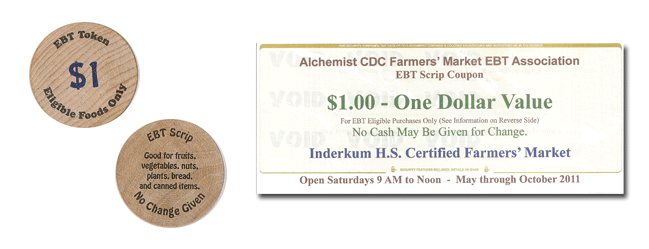 Designing and ordering your EBT Scrip is the next step. If you wish, you may do this before you receive FNS authorization. The scrip design does not have to be approved by state or federal entities, however there are some design requirements for all farmers’ market EBT scrip. See EBT Scrip Design Requirements below.
Designing and ordering your EBT Scrip is the next step. If you wish, you may do this before you receive FNS authorization. The scrip design does not have to be approved by state or federal entities, however there are some design requirements for all farmers’ market EBT scrip. See EBT Scrip Design Requirements below.The market operator is responsible for scrip design and cost. The Ecology Center Farmers’ Market EBT Program may be able to assist by designing, ordering and/or purchasing EBT scrip for California Certified Farmers’ Markets. If you require assistance with this, please contact us!
materials & quantity
- Paper is physically easier to handle than tokens, but potentially more easily counterfeited. If you use paper scrip, “Kant Kopy” paper or similar non-photocopyable paper is recommended.
- Tokens can be cumbersome in large quantities, but are long-lasting and are less prone to counterfeit.
- While “wooden nickels” are very popular, plastic tokens are thinner and more durable, but more expensive than wood.
- Markets that expect a high EBT volume may choose metal tokens and a coin counter to reduce staff time counting the EBT scrip.
- 1000 tokens is suitable for most mid-size markets. Smaller markets (<10 vendors) may only need 500 tokens. For wooden nickels, 500 tokens cost approximately $120 and 1000 tokens cost approximately $170. Large markets may want to consider greater quantities.
- Printing or stamping serial numbers on all scrip is optional, and increases the cost.
design and handling rules
Design:- Market or association name or logo
- Must say “NO CHANGE GIVEN”
- Must say “EBT” or “SNAP”
- Token denominations must be in whole dollar amounts (i.e. $1, $5, $10, etc.)
Handling:
- EBT tokens/vouchers never expire. If a customer uses an old EBT token/voucher from your market, you must honor it (Because the funds went from their EBT account into the market’s bank account when they purchased the EBT token/voucher).
- If a vendor that does not sell EBT eligible items takes a payment in EBT tokens/vouchers, the market should not reimburse the vendor for those tokens/vouchers. The vendor will have to eat that cost. It’s important to educate your vendors on what EBT scrip can be used to purchase (See Step #7: Vendor Education).
- If your market needs more funding to support the EBT program, you may consider increasing stall fees or taking a percentage of vendors’ TOTAL sales, not just EBT sales. This way, EBT sales aren’t discriminated against.
- If a customer would like to return EBT tokens/vouchers, you must honor that and return the funds to their EBT card.
contacts
Wooden Nickel Company
800-750-9915
www.wooden-nickel.comPlasco Token Factory
888-486-5367
www.tokenfactory.comOrdertokens.com
888-486-3749
www.ordertokens.comEcology Center Farmers’ Market EBT Program
510-925-4001
ebt@ecologycenter.org
Staffing & Redemption Models
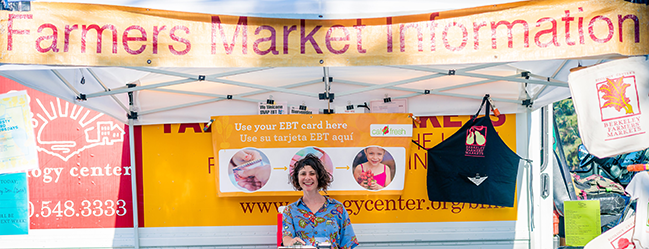
The POS device and responsible staff-person should be easily located by customers. The ideal location is a clearly marked, staffed market information table, office or vehicle. Likewise, redeeming EBT scrip should be simple and expedient for market vendors and farmers.If you do not have the staff or funding to staff an information table, OR you expect to have very high volumes of EBT sales, the staffing and redemption ideas below may be right for you.
If you aren’t sure which will be best, or you have a unique market situation, we are available to help with this. Please contact us!
Staffing models
If the market has no staffed information table, office or vehicle, some creative solutions include:- The market manager carries the POS device and tokens with them and wears a conspicuous uniform like a yellow shirt or red cap and a name badge. A sign in the middle of the market says, “To use your CalFresh EBT card, see Mary, wearing a red cap.”
- A farmer or vendor agrees to do EBT/scrip transactions for the market at their stall
- The market management sets up a revenue generating activity to pay for the staff time of the individual who operates the POS device and administers EBT scrip, e.g. selling T-shirts
- A community organization, such as a food bank, staffs the EBT table potentially in conjunction with other funded activities such as nutrition education or SNAP outreach
- A small increase in stall fees to pay the wages of a person to staff an EBT transaction table at market
redemption models
The vendor reimbursement procedure for EBT Scrip redemption should be fair and manageable for both market staff and vendors. Only vendors of eligible food items may be reimbursed for scrip.Models for reimbursement systems include:
- Cash reimbursement at the time the vendor turns in the tokens (or in place of a stall fee)
- A check written by the manager to the vendor at the time the vendor turns in the tokens
- A receipt given by the manager to the vendor at the time the vendor turns in the tokens, with a check or cash given to the vendor for the amount of the receipt the following week
It is not allowable for a farmers’ market to take a percentage their vendors’ EBT sales. If your market needs more funding to support the EBT program, you may consider increasing stall fees or taking a percentage of vendors’ TOTAL sales, not just EBT sales.
Record Keeping & Accounting
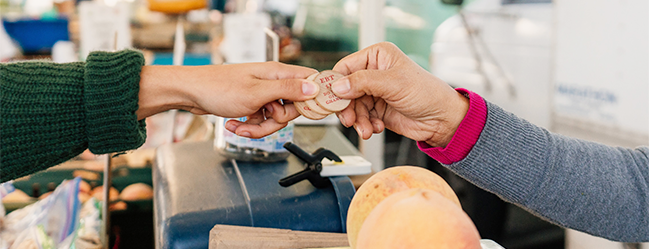
Record keeping and accounting is important at any farmers’ market. Adding a CalFresh EBT program means accounting for a new form of currency in the market. The amount of CalFresh sold (distributed scrip) and redeemed by vendors will not always be the same, as sometimes customers hold on to the scrip for use on another day. Because outstanding scrip is a liability for your market or organization, it is important that you account for it and ensure that the funds are earmarked.Likewise, the market manager, Board Treasurer or Bookkeeper will want to make sure that all CalFresh EBT transactions post to the market’s bank account.
Best Practices
Best Practices for Record-Keeping and Accounting Systems- Treat EBT scrip like you would any currency. Never leave scrip unattended at the info booth.
- Some markets opt to check in and out a pre-determined amount of scrip to the market manager at the beginning and end of the market day. This method ensures checks and balances for the EBT currency.
- Your wireless POS device will generate a record of total transactions after each market day. This can assist with the end of market-day reconciliation between scrip distributed and redeemed.
- You should record the number of tokens/vouchers you redeem from each vendor each day and the total number of tokens redeemed each day.
- The record of total transactions and the daily total of tokens redeemed will be different, as some tokens are kept by customers to spend, or vendors to redeem another day.
- The outstanding amount should be earmarked in case the scrip is redeemed at a later date.
- Sample record-keeping forms are available under Templates below.
Templates
Record Keeping Forms:
EBT Edge
Check your EBT deposit history and clear manual vouchers onlineFirst you will need to create a Merchant account on EBT Edge:
- Go to Merchant Log In and go to “register online now.”
- On the Merchant Registration page, enter your FNS #, phone number you used to register with the state, create a username and password, and answer three security questions.
*Note: If you run multiple farmers’ markets, you will need to create a separate account for each market.
To view your 1099K Form:
- Go to Deposits & Invoices
- In the upper right-hand corner, click on View 1099K Form
- Choose the year that you would like to view
To clear vouchers/see outstanding vouchers:
- Click on Voucher Clear Processing (Open)
- If you have any available vouchers to be cleared, they will appear on the screen
- Click on the empty square boxes to check/select the vouchers that you want to clear
- Then, click on the box that says Process Checked Vouchers
- The system will let you know it has successfully cleared them
To see Deposits/Invoices(Transactions)/Claims:
- Click on Merchant Deposits/Invoices/Claims
- Select the date or date range
- Click on Show deposits
- The system will show any recent deposits (Keep in mind deposits may occur up to two business days after the transactions. Be sure to include these days in your search range.)
- Click on the settlement date to the left (This will bring up all of the transactions for the desired date)
- On this same screen you have the option to Save the information in either Excel or PDF format
*Note: Deposits from out-of-state cards may be listed on a separate line.
To order offline vouchers:
- Go to the Services tab
- Select Offline Vouchers and the quantity
- Click Add and click Create Order Form
Merchant Services Support:
800-894-0050
Merchant.Services.Support@fisglobal.com
Vendor Education
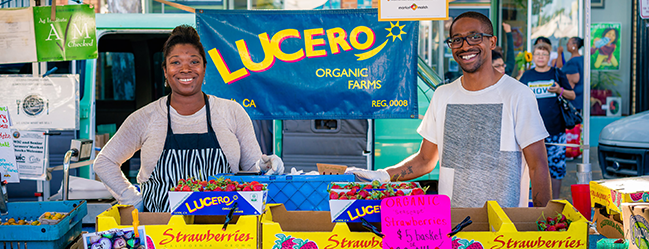 Educate Vendors in Scrip Redemption Rules and Procedures
Educate Vendors in Scrip Redemption Rules and ProceduresVendor education is an ongoing process. The market operator should educate returning vendors and new employees about EBT scrip, how the process works, and which products are eligible. SNAP rules state no U.S. currency is to be given as change and that each customer must receive full value for scrip.
Vendors should be able to direct customers, who want to shop with their EBT cards, to the information booth or staff person to get scrip. Further, vendors can help to promote EBT use at the market through their interactions with customers. For resources on vendor education in English and Spanish, click on templates below.
Please review USDA’s SNAP retailer permit training materials to be aware of all regulations that you must comply with.
Templates
Sometimes it may be neccessary to provide a “cheat sheet” for your market vendors. This is especially useful if you have multiple types of market currency (EBT, Credit/Debit, WIC, incentives.) A cheat sheet will provide the information about the program to your vendors, including photos of your various market currencies. If you want assistance modifying these templates, please contact us.Farmer/Vendor Handouts:
- Farmer/Vendor Scrip Guide Example (English and Spanish) in Microsoft Word Document
- Farmer/Vendor Informational Handout (English) in Word
- Farmer/Vendor Informational Handout (English) in PDF
- Farmer/Vendor Informational Handout (Spanish) in Word
- Farmer/Vendor Informational Handout (Spanish) in PDF
- Vendor/Association Agreement – This can be used as an agreement between farmers and an organization (other than the farmers’ market management) for operation of an EBT redemption system by the association within a farmers’ market or flea market.
At-Market and Community Promotion
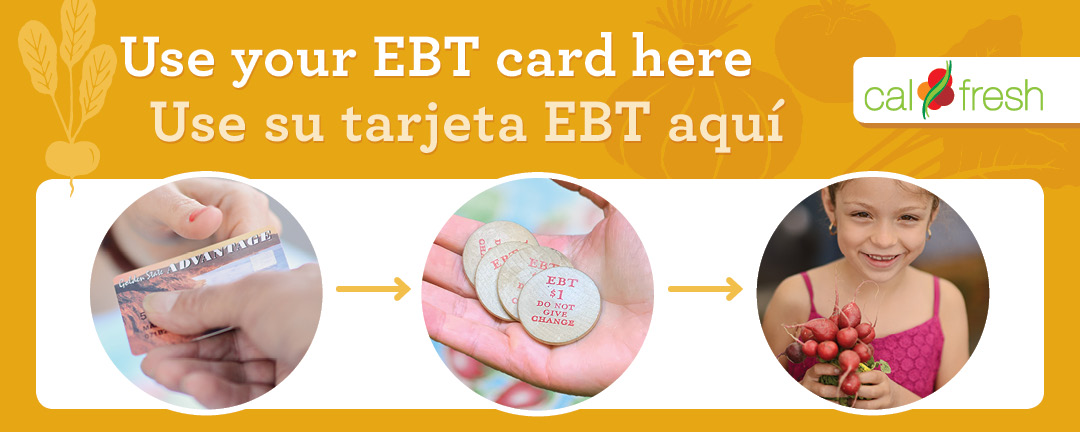 Here you will find editable promotional materials like posters and banners for establishing and promoting your market’s EBT program.
Here you will find editable promotional materials like posters and banners for establishing and promoting your market’s EBT program.We may be able to assist farmers’ markets in need with design, order and purchase of EBT Scrip as well as other promotional materials. Please contact us for more details.
At Market Promotion
The very first place you want to promote your CalFresh EBT program is at your market! Be sure to hang clear, visible signage that alerts customers that they can use their benefits there. If you do not have a central table or information booth, make sure that there is signage directing customers to where they can swipe their card.You can download free signage and customizable outreach brochures and posters under Free Promotional Materials below.
For other promotional ideas, visit the FNS website.
Community Promotion & Education
Keeping your market accessible to all customers entitles bragging rights. Send out a press release, post it on your website and marketing materials, and include it on all posters and flyers distributed throughout your community!When conducting outreach, consider joining forces with other farmers’ markets in your county, as well as local organizations and social service agencies, to launch an outreach campaign. Distribute informational and promotional flyers through your community’s faith groups, local coffee shops, and community and senior centers. Consider translating your materials so they are accessible to non-English speakers. Finally, remember to promote your market’s new EBT Program during market events such as grand openings, tastings, and cooking demos!
Farmers' Market Finder
Get included in our online and mobile Farmers’ Market Finder tool: FMFinder.org. Please visit the site and check your market’s information. If your market info needs to be updated, or you have newly added EBT access, please email us at ebt@ecologycenter.org.
Free Promotional Materials
FREE! Our new beautifully designed informational and outreach materials for use at your market and in your community. We have the following bilingual materials available for markets, free of charge. You may also download and print on your own by clicking the links. Please contact us at ebt@ecologycenter.org to receive some by mail. Be sure to tell us the type of scrip you are using (tokens or paper) and the quantity of each type that you require.If you need a version for professional printing (with bleeds), please reach out and we can provide one for you.
AT-MARKET MATERIALS:
Info Booth Poster
This 11″ x 17″ information booth poster describes the EBT process both verbally and visually. There are separate English and Spanish versions, and each also has paper scrip/vouchers and token options.Vendor Booth Sign
This 8.5″ x 11″ bilingual English/Spanish vendor booth sign offers two options – one with paper scrip/vouchers and the other tokens.EBT Coming Soon Sign
This 11″ x 17″ bilingual English/Spanish poster lets customers know that EBT is coming soon to your market.EBT Banners
This 2′ x 5′ banner visually depicts the scrip/central POS model and is a great addition to your information booth or EBT station. It is available as either bilingual English/Spanish or English/Mandarin. There are two versions for each language; one depicting paper scrip/vouchers and the other tokens.EBT Token Guide for Customers
This 8.5″ x 11″ sheet explains what EBT customers can and can’t purchase with EBT tokens at the market. This is useful to have at the information booth.COMMUNITY OUTREACH MATERIALS:
EBT Outreach Poster
This 11″ x 17″ bilingual English/Spanish poster is a great outreach tool in your community. Simply add in your market(s) information.EBT Outreach Flyer
These 8.5″ x 5.5″ (half-sheet) bilingual English/Spanish flyers can be disseminated in your community. Simply add in your market(s) information. Intended for in-house printing, there are two flyers per page. Simply cut down the middle to make half-sheet flyers.EBT Tri-fold Brochures
We also have customizable, county specific brochures and inserts available by request. The are available in five different languages: English, Spanish, Chinese, Vietnamese, and Armenian. Take a look at the examples below, and if you would like one made for your county, reach out to us at ebt@ecologycenter.org or at (510) 925-4001.Please see the additional languages we have available below:
Contacts
For free, printed signage, contact:Ecology Center Farmers’ Market EBT Program
510-925-4001
ebt@ecologycenter.orgIncentive Programs
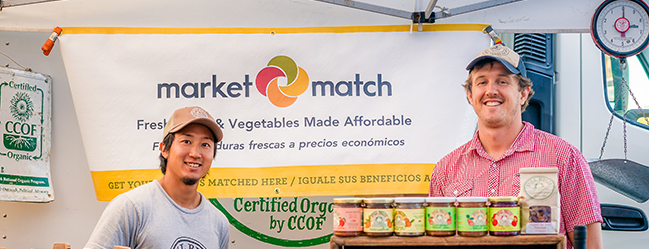 Market Match is the state’s largest CalFresh (SNAP) incentive program. It is led by the Ecology Center and offered by a network of 50 farmers’ market partners, at more than 280 sites. If you are interested in learning more about Market Match, please visit the Market Match website for more information, or contact our team at marketmatch@ecologycenter.org.
Market Match is the state’s largest CalFresh (SNAP) incentive program. It is led by the Ecology Center and offered by a network of 50 farmers’ market partners, at more than 280 sites. If you are interested in learning more about Market Match, please visit the Market Match website for more information, or contact our team at marketmatch@ecologycenter.org.Additional Information
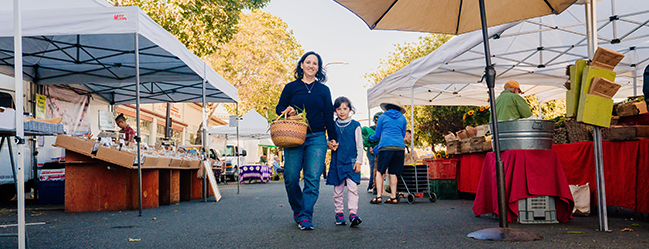 Some markets don’t fit the mould. If you need more info about making CalFresh EBT access work for your market, check out these topics, or contact us today.
Some markets don’t fit the mould. If you need more info about making CalFresh EBT access work for your market, check out these topics, or contact us today.What is a Certified Farmers' Market?
A Certified Farmers’ Market (CFM) is a “point of sale” location for California agricultural products. CFMs are usually set up on a weekly basis for California farmers and ranchers (“producers”) to gather together and sell their agricultural products directly to the public.A Certified Farmers’ Market may only be operated by a local government, a certified producer or a non-profit organization. CFMs must be authorized by the county agricultural commissioner and abide by current legislation and regulations. In addition, CFMs should follow established market rules. Market rules are the set of written rules each CFM develops as its blueprint for activities and operations.
Only producers certified by the county agriculture commissioner may sell at a CFM and must display their Certified Producer Certificate, and a sign with language akin to “We Grow What We Sell.” The re-sale of agricultural products at a CFM is prohibited.
While the look and feel of Certified Farmers’ Markets throughout the state varies greatly from county to county, the one thing they all have in common is the selling of agricultural products grown or raised in California. They ensure a direct connection between consumers and the farmers that grow their food. Being a CFM also opens up the opportunity to take advantage of the free POS device program through the California Department of Social Services, as well as free resources from the Ecology Center when setting up an EBT program. It also allows you to be listed on the Ecology Center’s online farmers’ market search tool and map, Farmers’ Market Finder.
If you are interested in becoming a Certified Farmers’ Market and your market is located in one of the counties listed here, you can complete the online application. If your county does not participate in CDFA’s online application system, then you can contact your county agricultural commissioner’s office to find out how to register.
California Department of Agriculture Certified Farmers’ Market Program
(916) 900-5030
cfm@cdfa.ca.gov
https://www.cdfa.ca.gov/egov/farmersmarketFor more information or support with setting up a new Certified Farmers’ Market, please visit farmersmarketalliance.org.
Assembly Bill 537
In cases where market operators do not take on the responsibility of implementing EBT, an association of vendors can be formed and may apply for and implement the system on behalf of the other market vendors. An association of eligible vendors should be formed by each vendor/member signing an agreement to be a member and to follow SNAP vendor rules and market scrip handling rules. The association representative, can apply to FNS as the “owner” of the farmers’ association and will be responsible for maintaining the FNS license in his name, along with any EBT Point of Sale (POS) device and scrip.If you are interested in this model, contact us and we can connect you with organizations that have taken on this role.
Flea Markets and Swap Meets
A flea market or swap meet must form a Farmers’ Market Business Association, with only eligible food vendors as members, before applying with FNS. The flea market manager, or a representative willing to take responsibility for enforcing the rules, can apply to FNS as the “owner” of the farmers’ market. Your application should be in the name of this “farmers’ market” as flea markets are not usually eligible to qualify as SNAP retailers. USDA regulation states:“More than one-half (50%) of the total dollar amount of all things (food, non-food, gas and services) sold in the store must be from the sale of eligible staple foods.”
Accepting WIC & Senior FMNP
WIC is a federally-funded health and nutrition program for women, infants, and children. WIC helps families by providing checks every summer for purchasing healthy supplemental foods at farmers’ markets. There are two separate food benefit programs that can be spent at authorized farmers’ markets: WIC Farmers’ Market Nutrition Program (FMNP) checks and Senior FMNP checks.Both programs require authorization by the California Department of Public Health. For more information about program requirements and how to apply, please see our:

Find the application and training materials on WIC’s page for farmers and farmers’ market managers.
For additional information or assistance with WIC authorization, contact:
WIC Farmers’ Market Team
California Department of Public Health
916-928-8513
wicfmnp@cdph.ca.gov
FNS REAUTHORIZATION
Once your market becomes SNAP Authorized, you will need to renew your authorization every five years. When it is time for reauthorization, FNS will send you a letter in the mail with instructions. You will need to complete the reauthorization application within 30 days of receiving notice of reauthorization, so we recommend you complete it is as soon as you possibly can. Keep in mind, it may ask you to submit back up documentation, such as and ID or SSN, just as the original application did. 501(c)(3) nonprofits are the only type of outlet that are exempt from this requirement. For more information about ownership types, click here. If you are a 501(c)(3) nonprofit, we also recommend using the paper application form, because the online system asks for a SSN no matter the ownership type.If you have any questions, or need help with your re-authorization, feel free to reach out to us any time at ebt@ecologycenter.org or at 510-925-4001.
You may also reach out to the FNS Farmers’ Market Customer Service Hotline at:
312-353-6609
JOIN THE CALIFORNIA ALLIANCE OF FARMERS' MARKETS
The California Alliance of Farmers’ Markets is a coalition of farmers’ markets and affiliates from around the state, committed to working together for the betterment of our industry. The Alliance offers professional development training and best practices for market managers; policy updates and representation in Sacramento and Washington, DC; and automatic membership of the Farmers’ Market Coalition – a national industry group, among many other benefits.In 2017, the The Ecology Center was awarded a Farmers’ Market Promotion Program (FMPP) grant to further the work of the Alliance over the next three years. The Alliance will launch a statewide social media campaign using farmer-focused videos, images, and content. Alliance members will be the first to benefit from these promotional materials. The Alliance will also be rolling out the FMC’s Farmers’ Market Metrics tool to members, in order to enhance the tracking of data for evidence based market management and evaluation.
Find out more at www.farmersmarketsalliance.org
Support our Work!
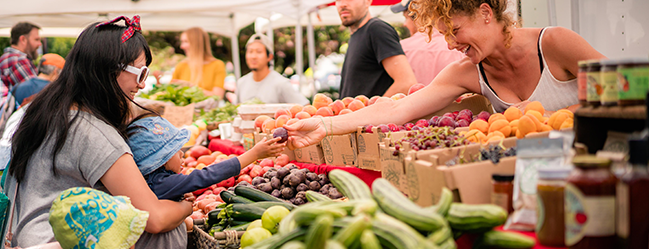 In order to do this important work, the Ecology Center relies on donations from people like you. If you can support our work by making a contribution to the Ecology Center, please do! The Ecology Center is a federally recognized 501 (c)3 non-profit and all donations are tax-deductible. Click here for more information.
In order to do this important work, the Ecology Center relies on donations from people like you. If you can support our work by making a contribution to the Ecology Center, please do! The Ecology Center is a federally recognized 501 (c)3 non-profit and all donations are tax-deductible. Click here for more information.This project has been funded at least in part with Federal funds from the U.S. Department of Agriculture. The contents of this publication do not necessarily reflect the view or policies of the U.S. Department of Agriculture, nor does mention of trade names, commercial products, or organizations imply endorsement by the U.S. Government. USDA is an equal opportunity provider.




